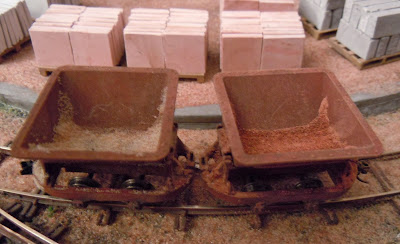The Thakeham Tiles railway only ever needed a couple of skip wagons, though there seemed to be one or two "spares" in the siding by the engine shed. Now I have plenty of O14 wagons from Landswood Park, I even have skips, but they are "weathered" with coal or manure, and that didn't seem appropriate for Thakeham! So another triplet of the lovely KB Scale Hudson Skip plastic kits were made up, with small strips of lead on the underside and in the bottom of the skips to add weight.
Time is running short now so I needed a way to paint and weather them quickly. First they were given a coat of red oxide primer (blu-tak in the bearings protects them), then a thinned wash of rusty brown. While that was still tacky weathering powder was stippled into the paint to give a varying texture and colour. The photo below shows the result of this, and a wagon still in primer. As I'd forgotten to add the lead before the primer this is clearly visible too.
Time is running short now so I needed a way to paint and weather them quickly. First they were given a coat of red oxide primer (blu-tak in the bearings protects them), then a thinned wash of rusty brown. While that was still tacky weathering powder was stippled into the paint to give a varying texture and colour. The photo below shows the result of this, and a wagon still in primer. As I'd forgotten to add the lead before the primer this is clearly visible too.

After that well thinned dirty black was applied around the axle-boxes, coupling pockets, and the skip "rocker" to suggest grease seeping through the rust. For a relatively quick method the results were very pleasing, and prototypical as the skips used at Thakeham seemed to have no sign of paint left on them!
Finally a little dilute PVA was applied followed by the sand where it would collect on the frames and stick in the bottom of the skip (and hide the lead weight!). The two wagons the line used were for different colours of sand, which I have represented. These two are coupled together semi-permanently with the link and pin supplied in the kit, and Microtrains couplers on the end, the third skip will mostly languish in the siding.
Finally a little dilute PVA was applied followed by the sand where it would collect on the frames and stick in the bottom of the skip (and hide the lead weight!). The two wagons the line used were for different colours of sand, which I have represented. These two are coupled together semi-permanently with the link and pin supplied in the kit, and Microtrains couplers on the end, the third skip will mostly languish in the siding.

The Thakeham line existed for one purpose only, to move sand about, so the wagons need loads to carry! Rather than loose loading them (I don't want sand in my locos mechanisms!) I made up these simple false loads from offcuts of foam-core board shaped to fit in the skip, and a carved hump of expanded polystyrene. The black dot in the top is a small neodymium magnet, of which more next time...

These were finished with a coat of brown paint and a couple of layers of the coloured sand again over PVA. Here they are seen loaded into the skips via the access hole inside the sand hoppers, next to the control panel.


No comments:
Post a Comment